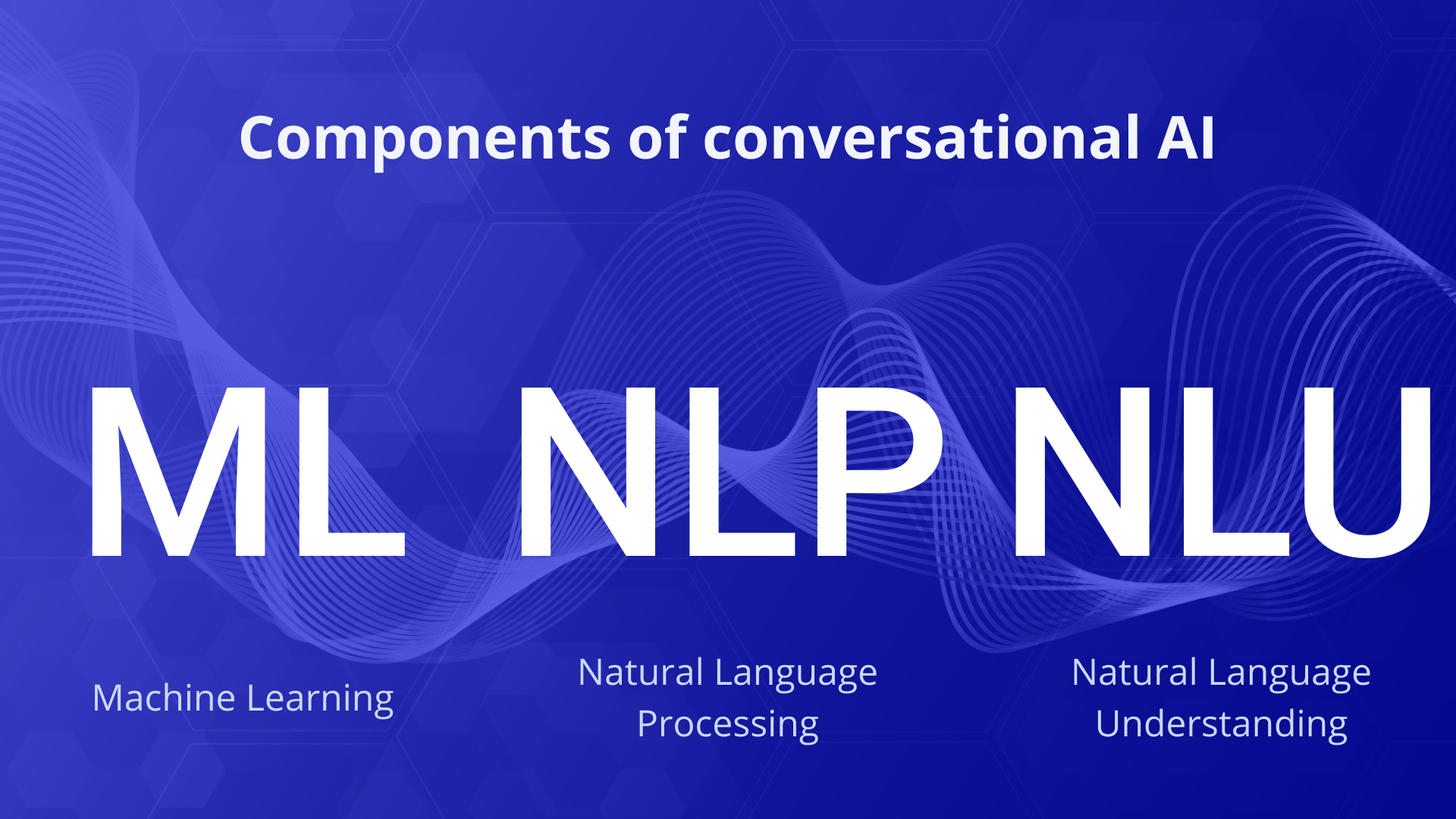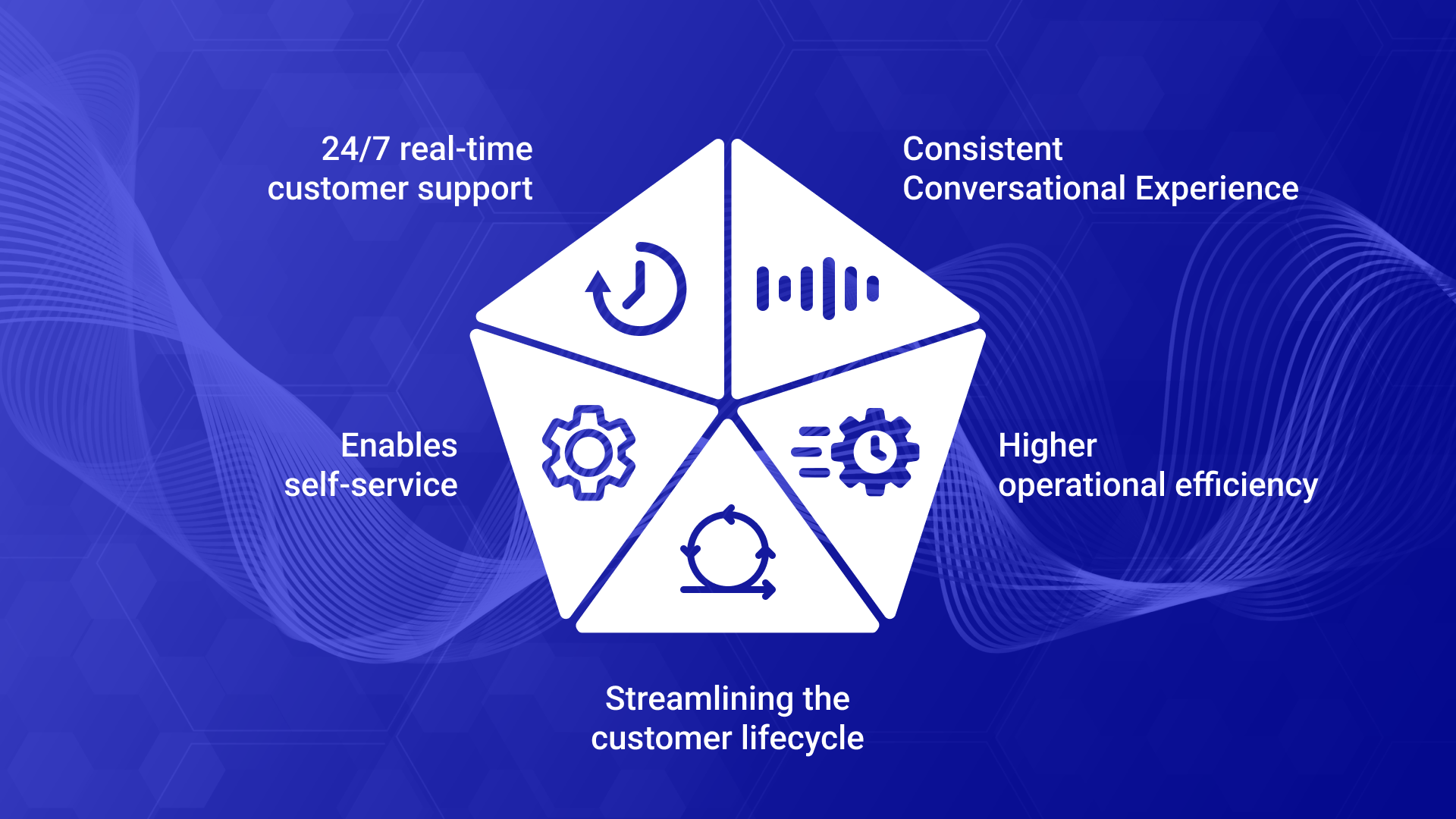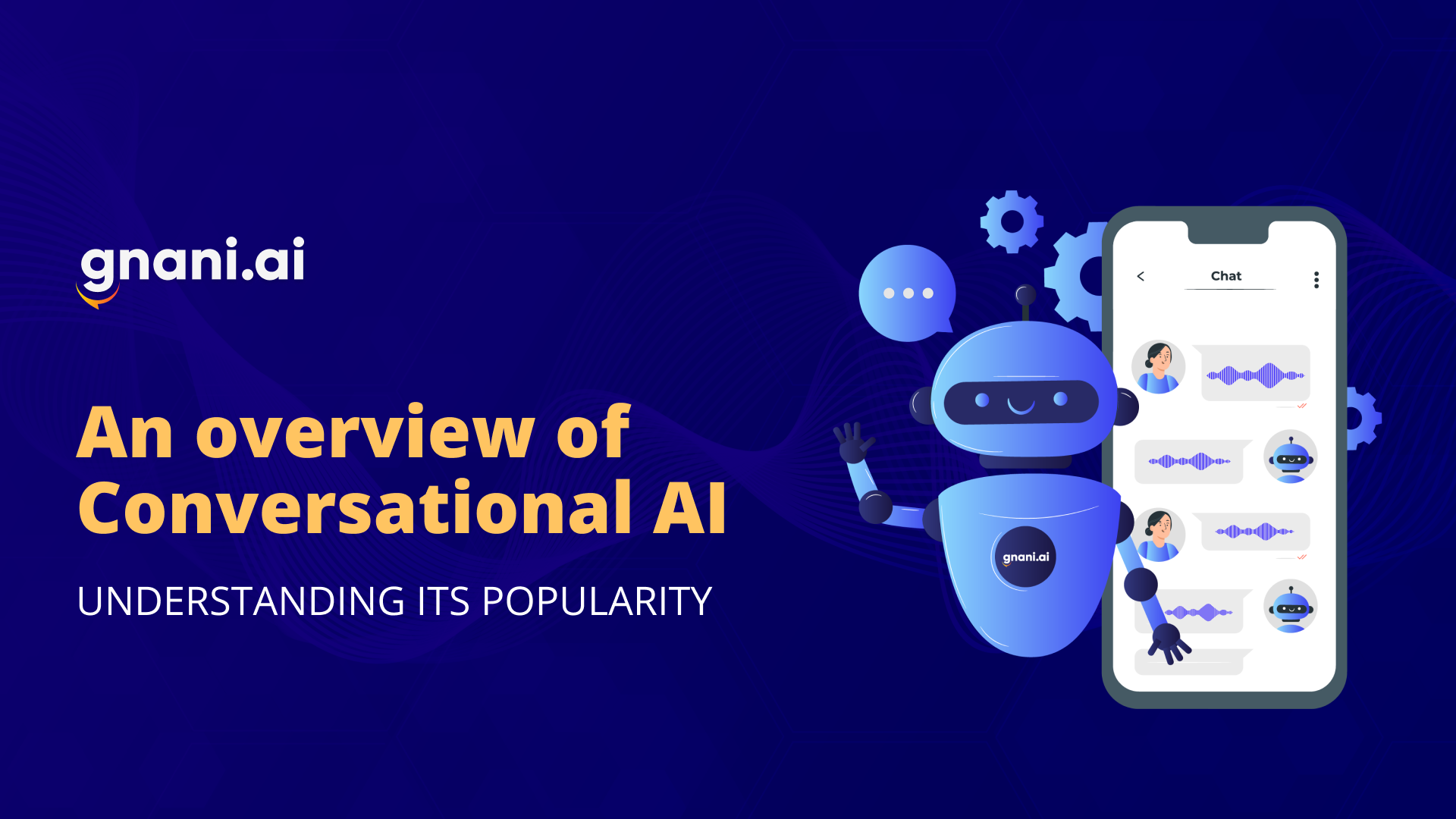In the second half of the 20th century, numerous science fiction movies had talking computers executing voice commands. The characters and computers would engage in natural conversations and the latter carried out complex tasks with minimal instruction.
In 2022, these scenarios are fast turning into reality. Virtual assistants are becoming indispensable for daily life, business processes, and more. Conversational AI is evolving at a fast pace making all these automation scenarios possible.
Conversational AI is a fast-growing segment in the market, with the domain having filed among the largest number of patents last year. Gartner estimates that by the end of 2022, 70% of white-collar workers will interact regularly with conversational AI in some form. Businesses that haven’t adopted it yet would do well to find out what the buzz is all about.
This post is a detailed journey through what conversational AI is, how it came about, and the ways in which it has been transforming the digital landscape.
What is Conversational AI?
Conversational artificial intelligence refers to the set of technologies that enable human-like conversations between people and computers. The machines process the words, sentiments, context, and purpose in the language to respond to text or voice inputs. They use machine learning (ML), natural language processing (NLP) and natural language understanding (NLU) to communicate with us and deliver responses.
It is a move forward from decision tree-based chatbots, which work linearly and can only provide pre-programmed answers that meet the if/then logic. Conversational AI is based on gigantic data sets being fed to machine learning algorithms to ‘train’ them. It can recognize user intent and context, and provide personalized answers to user queries.
The Development & History of Conversational AI
The first person to pay homage to when talking about AI is Alan Turing, the British cryptoanalyst, famous for breaking the Nazi crypto code, Enigma, who gave the first public lecture about computers that could learn from experience and modify their own rules as they went along. He also theorized that computers could be developed to solve problems with guiding principles in the late 1940s.

By 1964, the first natural language processing program had been created by Joseph Weizenbaum, at the MIT Artificial Intelligence Laboratory. Eliza, the program simulated a human therapist, running a script called DOCTOR, which gave non-directional answers to user inputs. It used a pattern matching and substituting methodology with no framework for contextualizing events; which nevertheless made many people think that ELIZA had human feelings.
A similar program PARRY, written by Kenneth Colby, was an advance over ELIZA. It tried to simulate a person suffering from paranoid schizophrenia, modeling their behavior and showing a conversation strategy. Both programs were among the first to attempt the Turing Test, developed by Alan Turing to distinguish real AI.
Jabberwacky developed in 1981 was the next significant attempt to simulate human conversation, though its purpose was entertainment. Cleverbot is an evolved version of the project that went online in 1997. Created by Rollo Carpenter, its responses are not pre-programmed; it uses human input and responds heuristically with fuzzy logic.
From the mid-2000s we see the smartphone age which further accelerated the development of AI technologies across the board. There have been many popular virtual agents since then, scoring a high percentage in the Turing test like Mitsuku, Xiaoice, etc.
Why Conversational AI is Gaining Popularity Now
User experiences that involve the least amount of effort and best mimic natural human behavior become popular and are adopted rapidly. In recent years, voice searches have been expanding in popularity after developments in search engine algorithms and machine learning. Voice commands are being understood better than ever.
Speaking costs a lot less effort than typing, making voicebots have greater potential for penetrating the human cultural consciousness. Likewise, reading is also a more intense activity than hearing.
Conversational AI can automate different aspects of life, increase convenience, and enable smart decision making. It saves time, reduces labor, and consequently makes it easier for users to understand complex processes.
Components of conversational AI
The technologies that make up conversational assistants include:
Machine Learning (ML)
It is a subset of artificial intelligence to give computers the ability to carry out tasks without explicitly being programmed as coined by Arthur Samuel, a pioneer in the field. The process involves the development of machine learning models using large amounts of data and algorithms.
The training is similar to exam taking. The machine is fed with inputs and outputs and eventually, only input is fed and the generated output is compared to expectations. So, the machine generates its program which should be tested and evaluated. The more experience it feeds on, the better the performance.

Natural Language Processing (NLP)
In this field of artificial intelligence, computers analyze and interpret human language, and provide useful output. The language may be spoken or textual. It enables applications like automatic summarization, relationship extraction, speech recognition, translation, named entity recognition, sentiment analysis, and topic segmentation.
The first step is for the computer to understand the natural language input. NLP algorithms are based on machine learning algorithms, using the datasets to make statistical inferences and learning the rules automatically, instead of coding them all. NLP methods involve identifying discrete sub-units of speech or text, then figuring out how they fit together based on databases of records.
The speech recognition routine yields result in text form and hence its also called the speech-to-text process.
Next comes part-of-speech (POS) tagging or word-category disambiguation where the words are categorized and grouped according to their nature as nouns, verbs, adjectives, past tense, etc. This tells the machine the meaning of the statements.
Finally, there is the stage of text-to-speech conversion where the output in programming language format is converted into an audible or textual format for the user.
Natural Language Understanding (NLU)
Easy to confuse with NLP, the NLU process is a sub-domain within NLP, focused on making sense of the language after pre-processing. It helps recognize name entities, process semantics, etc. Different statements could have the same meanings, and it is NLU that helps the machines recognize this. It’s helpful in understanding synonyms, the same words with different meanings in varying contexts to understand the intent behind inputs.
Why are Businesses Investing in Conversational AI?
Businesses find conversational AI to be highly impactful in offering customers intelligent and highly personalized CX. The modern marketplace is incredibly competitive, with product innovations moving at a dizzying pace, leaving customer satisfaction as the distinguishing factor in a business’s success.
People now interact with brands in completely different ways, at various touchpoints in an increasingly digitized journey. Their needs have evolved and now encompass faster and more personalized service. Conversational AI holds the key to providing these personalized user experiences with minimal resource investment.

Businesses can adopt automation of conversations across various channels and devices to help customers connect more seamlessly. Chatbots and voicebots can be provided with large amounts of data and trained to answer user queries rapidly, without exhaustion. These solutions can deploy across messaging platforms, phones, social media and web pages.
The result is that users get to experience synchronized, personalized assistance, The business response turnaround time is smaller, communication with agents is frictionless and people also have the option of speaking in languages that they know. This means that businesses can spread into new markets without having to hire colossal numbers of native speakers.
Some other reasons for the spread of conversation AI:
- 24/7 real-time customer support: Virtual assistants can be set up for 24/7 access at a fraction of the cost involved in setting up the same scale of contact centers. They can easily dispense with simple, repetitive queries that expend the energy of human agents.
- Consistent Conversational Experience: As voicebots don’t tire, they can continue to maintain composure even when tasked with handling stressed-out, agitated users. As the system trains with more data and calls, it gets better at offering personalized interactions.
- Higher operational efficiency: Voicebots enable handling of the higher volume of calls while reducing the call duration as it eliminates waiting time when compared to IVR systems. Implementing FAQ bots also reduces the volume of simple queries. The time saved allows focusing on resolving more difficult tickets.
- Enables self-service: Many customers prefer self-service over speaking to reps if possible. Conversational AI increases the efficiency with which people can solve their problems.
- Streamlining the customer lifecycle: Incorporating conversational AI allows the brand to remain in touch with the customer over the entire sales cycle, from making a choice, clarifying its suitability to completing a purchase and after-sales service. The data gathered via omnichannel presence can help in retargeting and retaining customers.
Conversational AI Use Cases – Real-life Benefits of conversational AI
So how exactly are businesses adopting AI?
Here are a few famous examples:
- Alexa and Siri- voice assistants from Amazon and Apple, that carry out commands to control smart devices, play music, make calls, etc.
- Wells Fargo is integrating a virtual assistant into its digital banking app for better customer engagement.
- U.S. Bank’s smart assistant functions as an AI teller while Bank of America has a voice assistant Erica with millions of users.
- Healthtech is a key sector where conversational AI is being rapidly adopted and making headway:
- AI-powered assistants like Babylon Health’s Symptom Checker and France’s Covidbot helped in carrying out contactless screening of coronavirus symptoms and answered the public’s questions.
- Suki, a healthcare voice assistant records, transcribes, and organizes a doctor’s conversations and notes on patients. It then automatically fills up the corresponding Electronic Health Records (EHR).
There are numerous sectors like banking and financial services, insurance, etc. where conversational AI will become indispensable in a short while. Assistants like bill payment bots, debt collection bots, claim processing bots, etc. can automate these tasks and allow human talent to be used to solve other problems. Retail brands, food, and hospitality, e-commerce companies, etc. are also looking to enhance the involvement of conversational AI.
The most common use cases where these agents are already active include customer service with redressal of simple queries, and providing product information to customers who don’t need much of a push to make a purchase. One important use case is to manage customer complaints and reduce IVR wait time for critical issues like notifying of theft etc.
Deploying these technologies allows companies to focus their efforts on innovation and optimizing other processes.
Gnani.ai in The Conversational AI Space
Gnani.ai has positioned itself at the forefront of this technological revolution to offer high-quality voice AI software. With numerous voicebots covering diverse functions across sales and marketing, and customer satisfaction, numerous processes can be automated with impressive results for achieving business goals.
Gnani’s lead qualification bots are an innovative way to make the sales pipeline more efficient. By using an AI assistant to pre-qualify leads, the customer hears from you at the right time, increasing the chances of conversion. The bots can be used to schedule outbound campaigns, describe product features, and onboard after the purchase among other functions.
The story of the automotive sector provides a good way to see the effect of Gnani’s voicebots. They can provide 24/7 after-sales service with low waiting time, and provide a good customer experience with FAQbots to answer easy questions quickly. A brand can save up to 80% of operational costs.
For the FMCG sector, the omnichannel availability of the bots across social media, IVR, email, WhatsApp, etc. is a huge advantage. The API can be integrated easily into CRM and billing systems, shortening the sales cycle.
The voicebots offer support in over 20 languages and are highly scalable to boot. This results in great outcomes like a 300% revenue increase, and a 70% operating cost reduction for appointment bots alone. Clients have also seen a 5X increase in bookings.
In conclusion, conversational AI assistants are the future of customer service and many other customer-facing processes. A growing business can automate many functions using voicebots and see a dramatic transformation in revenues and efficiency.





